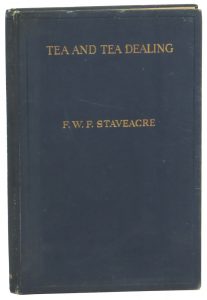Unsurprisingly, I picked this book out at the library for its blending section. I like reading first-hand, antiqued accounts of what goes into blends, and many of these works include sample recipes with the logic behind them. It puts a lot of stuff into context. Learning about old tea preferences, old blending nomenclature. I also come across a lot of defunct tea names.
These I’ve started keeping a log of (oonfa, oopack) to try and puzzle out what they’re referring to. Mbanu’s notes on teaforum.org help greatly; he’s done basically 100% of the legwork.
Though I picked Tea and Tea Dealing up for the blending section, I also picked it and The Management of Monopoly up because they focused on the economy at the time, and it reminded me of Xaiver over at Teaconomics. T&TD‘s focus, however, is as a guide for those hoping to break into the tea industry/get into running a production warehouse or wholesale, and not as an analysis.
Do I recommend reading this book in any modern sense if you’re thus interested in starting a tea business? No.
Most of the book has been replaced by computers, and the info that is still relevant, just isn’t for smaller companies. It’s directed towards producing plants and wholesalers who need help with book keeping and organizing their production floor. But it offers a historical look into business, blending practices, objectives, and tea machinery. Working with old machinery myself, this’ the third time I’ve found lithographs of our old 1920s blenders. I’m always excited to see them.
As mentioned, there were a few tea names that I hadn’t heard of before. Most often these are pre-pinyin terms with bizarre transliteration choices. But the one that stuck out the most was ‘Travancore’, a tea-producing ‘district’ of India (T&TD was published in 1929, before Indian Independence; ‘district’ seems to be used indiscriminately to refer to kingdoms, princely states, or modern-day districts) (but most bizarrely, I remember ‘Travancore’ from Eden’s being a pruning style).
Travancore–or, the Kingdom of Travancore–existed from 1729 until 1949, just after India gained independence. It covers parts of the modern-day states of Kerala and Tamil Nadu.2 So the immediate thought is that this’ an old term for teas coming out of the Nilgiri growing region. Unfortunately! Nilgiri is mentioned by name right alongside Travancore, and Staveacre even describes Travancore teas as having a profile quite similar to Nilgiri.1
This lead me down a rabbithole of complications. At the time of this book, there was a Nilgiri State (which merged into Balasore District in 1949). This was separate from the modern-day Nilgiri District, which is part of Tamil Nadu.2 The Nilgiri Mountains extend a length of Tamil Nadu and Kerala. Staveacre doesn’t give specifics on Nilgiri tea; I theorized originally that “Nilgiri” could refer to tea grown along the actual mountain range, with “Travancore” referring to tea growing in the same general area, just in the lower-lying ranges. Either that, or “Nilgiri” refers to tea from Nilgiri State, but that would put it in a completely different region from where modern-day Nilgiri tea is grown…
So I went off looking for specific Travancore estates whose modern-day locations I could pinpoint. Coming across Clemesha’s paper dealing with malaria in Travancore, it lists several estates said to be “…situated in an extremely unhealthy valley, viz., that of the Periyar.”3
Unluckily, the Periyar River runs through Kerala and Tamil Nadu.
Looking up several of the estates listed in the paper quickly lead me to the POABs Estates website4, which recounts the history of tea planting in Travancore. The website only speaks about modern-day Kerala, and all of the estates listed in Clemesha’s malaria paper show up on POABs’ website. This seems to put “Travancore Tea” pretty firmly in Kerala, not encroaching on modern Nilgiri tea in Tamil Nadu.
At this point, I was sleep-deprived and going in circles–it seems unlikely that the borders being redrawn post-independence didn’t manage to shuffle some estates between Travancore and Nilgiri, but I had to draw the line short of overlapping maps in photoshop and drawing points.
And so, pulling back from my violent historical aside to return to the main point (Travancore really deserves its own blog-post, if anything).
This book is relatively short, about 110 pages total; it would be about 2/3rds that if it used modern margins and formatting. Since a digital version of this book isn’t available, I’ve included the chapter-list below, to give an idea of what it provides. Chapters 1-3 are the usual affair, short and straightforward. 4-5, 7-9 are largely book-keeping and discussing (now defunct) auctions. The book reads well, despite the subject matter being kind of dry. I just lament that chapter 6 is woefully short.
The book is old, but doesn’t have the “name” behind it like Ukers, so pricing seems to be all over the place. The prices I spotted ranged from $29USD, $59USD, and $79USD.
Figures
Works Cited
- Tea and Tea Dealing, by F.W.F. Staveacre
- Wikipedia: Travancore
- Five Years’ Anti-Malaria Measures on the Travancore Tea Companies’ Estates, W.M. Wesley Clemesha (1930), at ncbi.nlm.nih.gov
- Poabs Estates Website (Planting History), at poabestates.com





Leave a Reply
You must be logged in to post a comment.